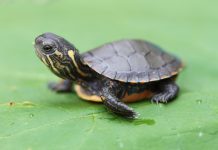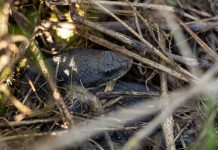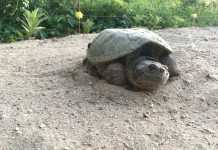Written by: Nicole Cameron (Canadian Conservation Corps)
All animals deal with the winter cold differently. Most big mammals make sure they have a nice layer of fat and extra thick fur, birds will migrate south to a warmer place, and a popular strategy for small critters is to hibernate. When most people hear “hibernation” they usually think of that long nap that bears take every day in the winter, but bears don’t actually hibernate. Bears, and many medium sized mammals like racoons and skunks, will undergo something called torpor. Torpor involves a lower metabolic rate and deep sleep, but it is short term and only lasts a couple of days at a time.
When an animal enters hibernation they undergo a number of physiological changes to drastically lower metabolic rate and body temperature so they can enter a sleep so deep they won’t wake up for weeks or sometimes months as long as they are left undisturbed. Another strategy that is often confused with hibernation is called brumation, which is popular among ectothermic (“cold-blooded”) animals like reptiles. Brumation is similar to hibernation in that it is extreme physiological changes for a long period of time. However in brumation, the animal does not need to sleep to maintain its low metabolism.
Wood Frogs
Wood frogs have one of the most remarkable and drastic hibernation techniques. They just freeze! Check out this video! Almost half (35-45%) of the water in their body turns to ice, and all muscles, including the heart, completely stop moving. Normally this kind of freezing would kill an animal, but wood frogs have a special adaptation that allows them to isolate the ice to locations in the body that are not harmful. When the temperature begins to drop the wood frog liver will release glucose antifreeze into the body to enter cells and prevent the ice from crossing the cell membrane. In this way a frog is capable of having ice surround the cells and organs but keep the inside of the cell protected and alive.
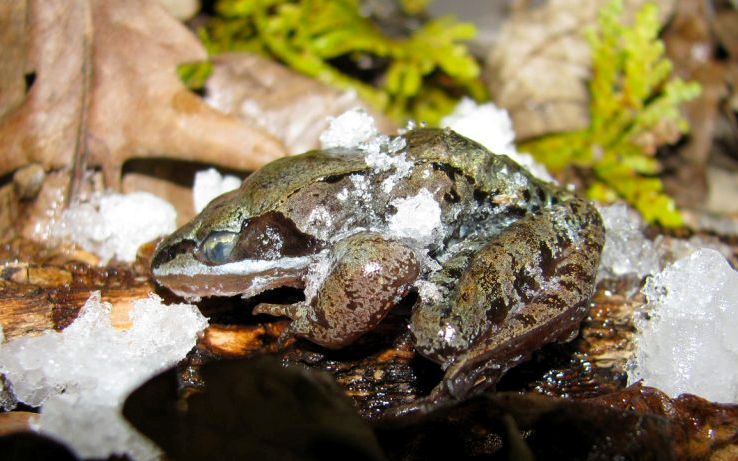
Eastern Hog-nosed snakes
Eastern hog-nosed snakes enter brumation like most snakes. However unlike most snakes, the eastern hog-nosed doesn’t like to brumate in groups. When the winter approaches they’ll go looking for an old hibernaculum, or an abandoned small mammal den, usually in grassy sand dunes or leaf littered forest floors. Sometimes they even find the perfect spot in manmade structures, such as the foundations of buildings or old wells. If an empty spot is unavailable they’ll use their shovel shaped nose to dig one themselves. Eastern hog-nosed snakes are expert hiders and are rarely seen even in the summer so you’ll probably never find one brumating.

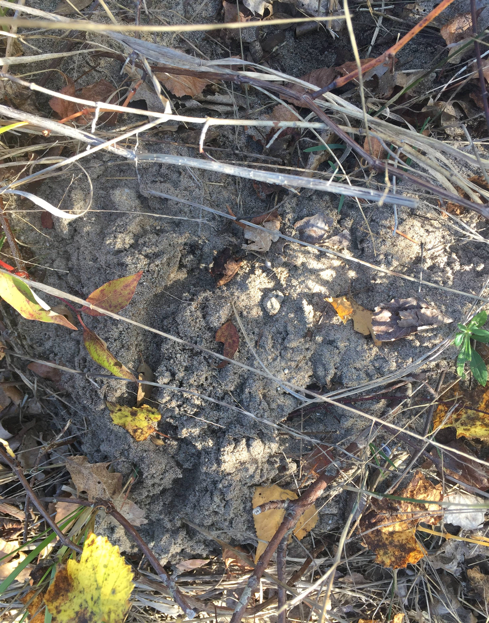
Turtles
Turtles brumate on the mud at the bottom of ponds, lakes and streams, and sometimes will bury parts of their body into the mud. The temperature of the water is likely to stay at a constant 1⁰C for the whole winter and turtles use this as an external temperature regulator. They use both the water temperature and the insulation they get from the mud at the bottom of the pond to keep their body temperature stable and above freezing.
For any other animal this would be a very difficult situation to breathe in, but turtles are capable of “butt-breathing”. They extract small amounts of oxygen from the surrounding waters through their cloaca and membranes in their throat. Another way some turtles deal with less oxygen is by switching to anaerobic respiration (without oxygen). Most animals can only survive anaerobic respiration for short period of time since is creates a toxic by-product called lactic acid (the stuff that causes your muscle cramps when you work out). Since turtles have a reservoir of calcium in their shells, they can combat the lactic acid build up and survive using anaerobic respiration for up to 100 days!

Climate change is affecting the way a lot of these reptiles and amphibians deal with cold. The physiological changes these animals undergo are often triggered by specific temperatures. Increasing temperatures in the middle of winter can sometimes reach temperatures warm enough for these animals to wake up too early and then have to go back under. This is very energy expensive and the animals don’t have the same access to food and resources that they would when waking up in the spring. Also with increasing temperatures, other migrating animals might stay further north for longer which could cause unexpected competition and complications with the food webs.
What can you do?
- Protect these animals by protecting their hibernacula.
- Take measures to reduce your impact on the climate.
- Report your sightings of a hibernating or brumating animal.
Nicole is a member of the Canadian Conservation Corps. The Canadian Conservation Corps (CCC) is now accepting applications from youth aged 18-30. As part of the program, participants will travel across Canada for wilderness training, enjoy conservation field experiences, and develop service projects. The program is presented by the Canadian Wildlife Federation with the support of the Government of Canada through the Canada Service Corps. For more information or to apply, visit CanadianConservationCorps.ca.



